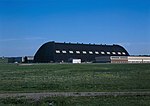Akron Executive Airport
1929 establishments in OhioAirports established in 1929Airports in OhioGliding in the United StatesTransportation in Akron, Ohio

Akron Fulton Intl Airport (IATA: AKC, ICAO: KAKR, FAA LID: AKR) is in Akron, Summit County, Ohio, United States. It is owned by the City of Akron; FAA's National Plan of Integrated Airport Systems for 2011–2015 called it a general aviation airport. Most U.S. airports use the same three-letter location identifier for the FAA and IATA, but Akron Executive is AKR to the FAA and AKC to the IATA (which assigned AKR to Akure, Nigeria).
Excerpt from the Wikipedia article Akron Executive Airport (License: CC BY-SA 3.0, Authors, Images).Akron Executive Airport
Triplett Boulevard, Akron East Akron
Geographical coordinates (GPS) Address Website External links Nearby Places Show on map
Geographical coordinates (GPS)
| Latitude | Longitude |
|---|---|
| N 41.0375 ° | E -81.466944444444 ° |
Address
Akron Fulton International Airport
Triplett Boulevard 1600
44306 Akron, East Akron
Ohio, United States
Open on Google Maps






